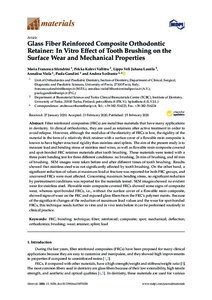Glass Fiber Reinforced Composite Orthodontic Retainer: In Vitro Effect of Tooth Brushing on the Surface Wear and Mechanical Properties
Annalisa Viola; Maria Francesca Sfondrini; Pekka Kalevi Vallittu; Paola Gandini; Lippo Veli Juhana Lassila; Andrea Scribante
Glass Fiber Reinforced Composite Orthodontic Retainer: In Vitro Effect of Tooth Brushing on the Surface Wear and Mechanical Properties
Annalisa Viola
Maria Francesca Sfondrini
Pekka Kalevi Vallittu
Paola Gandini
Lippo Veli Juhana Lassila
Andrea Scribante
MDPI
Julkaisun pysyvä osoite on:
https://urn.fi/URN:NBN:fi-fe2021042827526
https://urn.fi/URN:NBN:fi-fe2021042827526
Tiivistelmä
Fiber reinforced composites (FRCs) are metal free materials that have many applications in dentistry. In clinical orthodontics, they are used as retainers after active treatment in order to avoid relapse. However, although the modulus of the elasticity of FRCs is low, the rigidity of the material in the form of a relatively thick retainer with a surface cover of a flowable resin composite is known to have higher structural rigidity than stainless steel splints. The aim of the present study is to measure load and bending stress of stainless steel wires, as well as flowable resin composite covered and spot-bonded FRC retainer materials after tooth brushing. These materials were tested with a three point bending test for three different conditions: no brushing, 26 min of brushing, and 60 min of brushing. SEM images were taken before and after different times of tooth brushing. Results showed that stainless steel was not significantly affected by tooth brushing. On the other hand, a significant reduction of values at maximum load at fracture was reported for both FRC groups, and uncovered FRCs were most affected. Concerning maximum bending stress, no significant reduction by pretreatment conditions was reported for the materials tested. SEM images showed no evident wear for stainless steel. Flowable resin composite covered FRCs showed some signs of composite wear, whereas spot-bonded FRCs, i.e., without the surface cover of a flowable resin composite, showed signs of wear on the FRC and exposed glass fibers from the FRC's polymer matrix. Because of the significant changes of the reduction of maximum load values and the wear for spot-bonded FRCs, this technique needs further in vitro and in vivo tests before it can be performed routinely in clinical practice.
Kokoelmat
- Rinnakkaistallenteet [27094]
